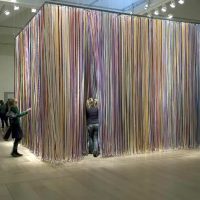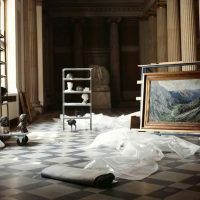(Az abstrakció csodálatos világa), Moderna Museet Stockholm 2006,
550 x 550 x 400 cm, Installáció, selyemszalagok
(Szépmuvészeti Múzeum), C-print, változó méret
100 years later, Dreamlands Burn is a large-scale exhibition presenting the work of fifty artists and art groups from five Northern European countries. Keeping in mind the artistic plurality of the scenes in question, rather than applying a comprehensive, and thus limiting, theme on a show featuring the work of fifty artists, we chose to unravel the story along the lines of the thematics, which actively operate within the exhibition.
In this way, the objective of this selection is more an attempt to offer a contemporary reading of the complex artistic reality of Northern Europe with the help of various concepts – nation, identity, statehood, personal versus public, the question of communities, etc –, metaphors and thoughts, and their overlapping or parallel representations. Thus, what has been created is not a thematic, but – to put it boldly – poly-thematic exhibition basically arranged around the artworks; it was in examining the individual pieces, series, artistic attitudes and strategies that the dialogues were formed, which we then attempted to expand to and operate in the entirety of the Mucsarnok.
For what can be called Nordic? What cultural particularities, regional similarities or sameness can we speak of, which, aside from the economic and often conflict-ridden historical relationships that have otherwise linked the Nordic countries, could serve as support for a similar cultural manifestation? Or: what can national or regional representation mean in 2006 in the context of a contemporary Nordic exhibition – what are its relevances and possible strategies?
We must not forget about the radically altered position of Northern European contemporary visual art in the international art scene at present, which is incomparable with its still peripheral situation and isolation of the beginning of the 20th century. As of the mid 90s, the seclusion of the art scene of the region, which had lasted up until the end of the 1970s, was superseded by a regionally oriented, never before seen international interest, as a result of which the art scene of the Nordic countries can be discussed as an inherent constituent of the international art scene.
A re-evaluation of the relationship between the periphery and the centre(s) becomes increasingly more obvious. In this process, the art of the Northern European countries does not only measure its results in relation to itself – it acquires meaning and interpretation not only in its own national context, but in an international one as well.
The title of the exhibition is meant to point to the poetics of contradictions. It refers not only to the voices of the presented pieces with their emphatically critical tensions and paradoxes, but aims to move contrarily to the tendencies, which envisage the discourse on the art of the region along the lines of fixed ideas and cultural topoi.
In contrast, rather then ordering possible associations around a concept, the poetic title alludes to various conditions and processes. The dynamic that it stresses is also one of the fundamental structuring/conceptual principles of the exhibition. The interplay of the two basic states of dreaming (nightmare / lucid dreaming /daydreaming / fantasising / visions / delirium, on the one hand, and operating (often automatically) within the reality of everyday life, on the other, is a crucial element of the concept.
A significantly large number of the exhibited artworks is motivated by an interest in the strategies of individual identity construction – the circumnavigation of individual paths and possibilities, of the obstacles in finding one’s place. A number of pieces point to the, by no means, static essence of individual identity through perceptive stories of obsessions, passions and desires. A renewed interest in the history of the recent past and the essentially political nature of the mechanism of historical memory also provides the exhibition with an explicit “narrative line”. Moreover, works, which are directly inspired by questions of reality, and which speak about wider social issues through the analysis and elaboration of a local, special story, assume an important role.
The exhibition features projects made specifically for the spaces of Mucsarnok. The exhibition design of the show, which was conceptualised and created by the Uglycute formation operating in Stockholm, is one of these projects. By taking into consideration the arrangement of, and connections between, the spaces of Mucsarnok and the showcased pieces, this group, comprised of two artists, an architect and an interior designer, formulated mobile and easily constructed units, which determine the design of the exhibition. Sight-specific works include a wall painting by Danish artist, Jens Haaning, which is an adaptation of an earlier work of his; a light installation by Tommi Grönlund/Petteri Nisunen, which radically transform the entrance hall; and a made-for-finissage sound installation and performance by the fourteen-person formation of freq_out. The historical background of the show is reflected on by a new installation of New York-based Swedish artist, Sara Jordenö, which also features Northern pieces from the collection of the Museum of Fine Arts – bought from the exhibition that took place a hundred years ago. Danish artist, Gitte Villensen, stayed in Budapest for a month. Her photo installation on the once-legendary artist club, Fészek – the central subject of her research – can also be considered a visual script of a future film.
Dreamlands Burn consciously selects works from the analytical and documentarist sphere, which are capable of a complex, yet sensuous, representation of individual phenomena. The title is meant to allude to the critical, and often quite passionate, voices that manifest through the artwork, but also to the elementally creative force of the imagination, which infuses and powers these art scenes.
The thematic film blocks associated with the exhibition, Dreamlands Burn, unravel and further interpret the questions, which inspired the project, as well as the determinant subject matter that appears in the works. Viewers can enjoy the six film programs (with a length of one to one and a half hours each), consisting of videos and short films, in a cinema milieu at the Menu Pont Gallery, in the project space of the Műcsarnok/Kunsthalle which was specially transformed for this occasion.
The programs – which are held in the auditorium and have been organised with the collaboration of various film institutes – along with the related discussions and presentations take place within the framework of the BBS forum and situate the exhibition program in a more comprehensive cultural context.

